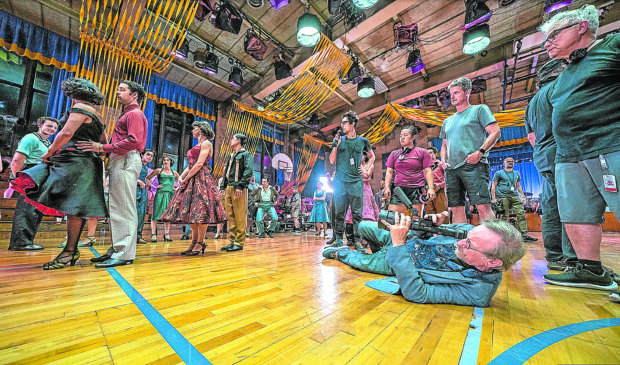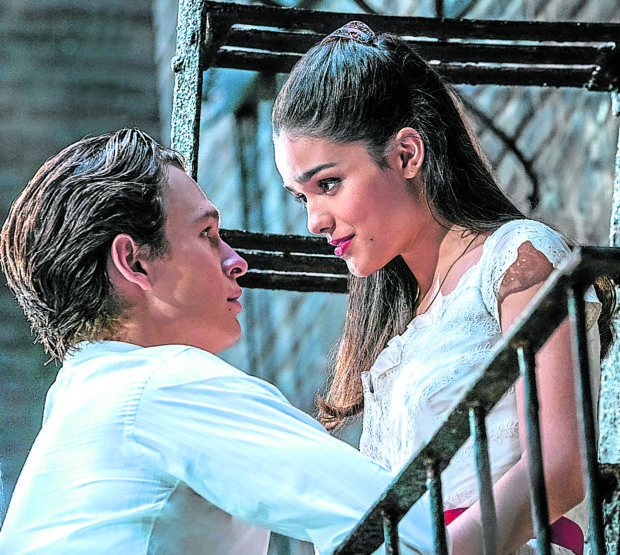Steven Spielberg on reimagining ‘West Side Story’: The rage and hatred had to be more pronounced (Conclusion)

Steven Spielberg on the set of “West Side Story” PHOTOS COURTESY OF WALT DISNEY STUDIOS
Seen side by side with Robert Wise and Jerome Robbins’ 1961 big-screen version of the 1957 Broadway musical, Steven Spielberg’s movie adaptation of “West Side Story” is exhilarating to behold.
Last November, we watched both films one after the other to see why the former needed to be revived. Without beating the bush, Spielberg’s Oscar-nominated production easily exceeded our expectations.
We were the only print journalist present at the screening of the new film, but we were embarrassed just the same to come out of the theater after having cried our eyes out over the hot-button issues Spielberg and screenwriter Tony Kushner manage to incorporate into this tale of love striving to rise above hatred.

Ansel Elgort (left) and Rachel Zegler
Pertinent themes
More reverential than revisionist, the new film starring Ansel Elgort as Tony and newcomer Rachel Zegler as Maria may be set in the ‘50s, but it makes its pertinent themes on racial conflict, immigration, abuse of authority, rape and misogyny resonate with present-day, punch-in-the-gut pertinence. “West Side Story” will finally be shown in Philippine theaters beginning on Wednesday.
We were blown away as much by the film’s thematic breadth and visual beauty as by the organically limned portrayals turned in by actors who manage to bust out of proscenium-style characterizations.
But more than anything, we were thrilled to “virtually” meet Spielberg and have him personally explain to us his vision for “West Side Story”—straight from the horse’s mouth!
Our Q&A with Steven Spielberg:
Getting Rita Moreno, who won an Oscar 60 years ago for her role as Anita and now plays the crucial character Valentina, to appear in the new version was a stroke of genius. And making her sing one of the musical’s most unforgettable songs is an indubitable highlight that brims with relevance and nostalgia. How did that exhilarating tweak come about?
The idea came from Tony Kushner, the writer of the adapted screenplay. One day, while Tony was writing the script, his husband Mark Harris said to him, “Hey, you should not have Doc (played by Ned Glass in 1961) in your story. Why don’t you have Doc’s widow instead, and make her Puerto Rican, then let Rita Moreno play her?”
Tony called me on the telephone and said, “This is probably a crazy idea, but you’re not gonna believe what Mark just said. But what do you think? And I freaked out when I heard that. I said, “Oh, my God—that’s exceptionally great! So, yeah, it’s an idea that just came out of the evolution of how we started putting the story together.
Despite being set in the ‘50s, the film’s themes of racism, fear, othering and violence still resonate strongly today. What answers have you found within the story and its music that can offer hope to our divided countries and communities today?
I’ve always felt that the effort to simply sit down and have a conversation as opposed to violently or ideologically stating your position without bringing your ears to the discussion … I think that’s the initial problem with the Sharks and the Jets.
And a problem that we’ve seen happening for many, many years in this country every single day is that there is less listening and more of stating one’s position. Like in “Romeo and Juliet,” although there’s no racial component in it compared to “West Side Story.” I really feel that there would have been a different outcome had Tony been at the first war council—although there would be no drama if you do that.
But when I came out of the other end of “West Side Story,” I was hoping it would be a cautionary tale that would convince people to get into rooms with those we don’t agree with, and talk about everything.
How did you find the balance between modern storytelling and, at the same time, paying homage to the previous film?
I wasn’t really trying to pay homage to the previous one, although I have deep respect for the previous one. I love it very, very much. I saw it when I was a teenager living in Arizona, so I have tremendous respect for it.
I also felt that the audience today is very demanding of authenticity. So, this needed to be an authentic representation of the Nuyorican and Puerto Rican experience. I wasn’t trying to make up for anything that history has done with the play or the 1961 film, because these were all different times, and people were certainly different. There’s a lot more sensitivity today than there ever had been before throughout Hollywood history.
But I poured out an effort to make this a street musical, not a theatrical musical—because Robert Wise and Jerome Robbins’ ‘60s movie that I loved so much was a hybrid between cinema and theater.
In my case, I wanted this adaptation to just be cinema. Therefore, this brought into the process a prerequisite that everything had to be more realistic, the characters had to be deeper, they had to have more interrelational and interpersonal connections. And the rage and hatred had to be much more pronounced and not safe at all.
So, I have to give credit where credit is due: Tony Kushner did an exceptional job reimagining his script, based on the original 1957 musical. Thereafter, everything just started building upon itself.














